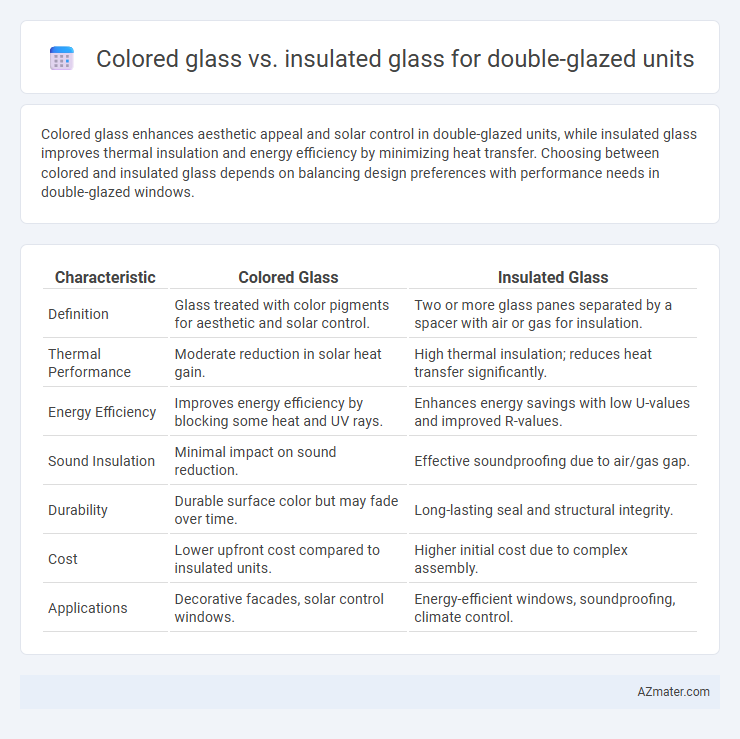Colored glass enhances aesthetic appeal and solar control in double-glazed units, while insulated glass improves thermal insulation and energy efficiency by minimizing heat transfer. Choosing between colored and insulated glass depends on balancing design preferences with performance needs in double-glazed windows.
Table of Comparison
| Characteristic | Colored Glass | Insulated Glass |
|---|---|---|
| Definition | Glass treated with color pigments for aesthetic and solar control. | Two or more glass panes separated by a spacer with air or gas for insulation. |
| Thermal Performance | Moderate reduction in solar heat gain. | High thermal insulation; reduces heat transfer significantly. |
| Energy Efficiency | Improves energy efficiency by blocking some heat and UV rays. | Enhances energy savings with low U-values and improved R-values. |
| Sound Insulation | Minimal impact on sound reduction. | Effective soundproofing due to air/gas gap. |
| Durability | Durable surface color but may fade over time. | Long-lasting seal and structural integrity. |
| Cost | Lower upfront cost compared to insulated units. | Higher initial cost due to complex assembly. |
| Applications | Decorative facades, solar control windows. | Energy-efficient windows, soundproofing, climate control. |
Introduction to Double-Glazed Units
Double-glazed units typically consist of two glass panes separated by a spacer and sealed to create an insulating air or gas-filled cavity, enhancing thermal efficiency. Colored glass in double-glazed units provides aesthetic customization and solar heat control, reducing glare and UV transmission. Insulated glass focuses primarily on maximizing energy efficiency, utilizing low-emissivity coatings and gas fills like argon or krypton to improve thermal insulation and reduce heat transfer.
What is Colored Glass?
Colored glass in double-glazed units incorporates pigments or coatings that alter light transmission and improve aesthetic appeal, providing enhanced solar control and reducing glare. Unlike insulated glass, which primarily focuses on thermal performance through air or gas-filled gaps, colored glass adjusts visible light and UV radiation levels, contributing to energy efficiency and comfort inside buildings. This type of glass is often combined with double glazing to balance heat insulation with decorative or privacy needs.
What is Insulated Glass?
Insulated glass, also known as double-glazed glass, consists of two or more glass panes separated by a spacer filled with air or inert gas to reduce heat transfer and improve energy efficiency. This construction enhances thermal insulation and soundproofing compared to single-pane or colored glass units, making it ideal for windows and doors in both residential and commercial buildings. Colored glass primarily focuses on aesthetics and solar control, whereas insulated glass emphasizes performance by minimizing heat loss and condensation.
Visual Appeal: Comparing Aesthetics
Colored glass in double-glazed units offers vibrant hues that enhance building facades and interior designs with artistic flair, creating distinct visual statements. Insulated glass prioritizes clarity and minimalism, providing a sleek and modern appearance that complements contemporary architectural styles. Choosing between colored and insulated glass depends on the desired aesthetic effect--whether emphasizing bold color accents or achieving clean, transparent views.
Energy Efficiency: Thermal Performance
Colored glass in double-glazed units absorbs and reflects solar radiation, which can reduce heat gain and improve energy efficiency in hot climates. Insulated glass, often featuring low-emissivity coatings and gas fills like argon or krypton, significantly enhances thermal performance by minimizing heat transfer and maintaining indoor temperatures. Combining colored glass with insulated glazing techniques boosts overall energy efficiency by balancing solar control with superior insulation properties.
UV Protection and Light Control
Colored glass offers effective UV protection by absorbing and filtering harmful ultraviolet rays, reducing interior fading and heat buildup in double-glazed units. Insulated glass enhances light control by incorporating low-emissivity coatings and gas fills that minimize solar heat gain while maintaining visible light transmission. Combining both technologies maximizes energy efficiency, UV blocking, and customizable light regulation for superior comfort and durability.
Acoustic Insulation Capabilities
Colored glass in double-glazed units offers minimal acoustic insulation enhancements compared to insulated glass, which is specifically engineered to reduce noise transmission. Insulated glass units typically incorporate air or gas-filled spaces between panes, significantly improving sound reduction by dampening sound waves more effectively than colored glass alone. For environments demanding superior noise control, insulated glass double-glazed units outperform colored glass options in acoustic insulation performance.
Durability and Maintenance
Colored glass in double-glazed units offers enhanced aesthetic appeal but can be prone to fading and surface scratches over time, requiring periodic cleaning with non-abrasive materials to maintain clarity. Insulated glass, designed with multiple panes and gas fills, provides superior durability against thermal stress and reduces condensation, resulting in lower maintenance demands. Both types benefit from quality seals, but insulated glass units typically offer longer lifecycle performance and resistance to warping or seal failure.
Cost Comparison: Colored vs Insulated Glass
Colored glass for double-glazed units generally costs less due to simpler manufacturing processes and lower material expenses compared to insulated glass, which involves multiple glass panes with air or gas-filled spaces for enhanced thermal performance. Insulated glass units (IGUs) often demand higher upfront investment but provide superior energy efficiency, leading to cost savings in heating and cooling over time. The choice between colored and insulated glass hinges on balancing initial expenses against long-term utility savings and aesthetic preferences.
Choosing the Right Glass for Double-Glazed Units
Colored glass enhances aesthetic appeal and provides solar control by filtering specific light wavelengths, making it ideal for design-focused projects. Insulated glass, featuring multiple glass layers separated by air or gas, significantly improves thermal performance and energy efficiency in double-glazed units. Selecting the right glass depends on balancing visual requirements with insulation needs to optimize both comfort and energy savings.

Infographic: Colored glass vs Insulated glass for Double-glazed unit
 azmater.com
azmater.com